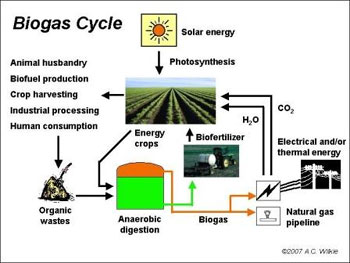If you follow our news you know we’re big boosters of biogas – a renewable form of natural gas made from methane waste from wastewater treatment plants, dairies and landfills.
The American Biogas Council selected a New Jersey wastewater treatment plant for its "Biogas Project of the Year" award.
With a goal of running the plant entirely on renewable energy, the Ridgewood, New Jersey plant combines biogas production, combined heat and power (CHP) and 50 kilowatts of solar.
After retrofitting the plant to optimize biogas production, they added enzymes and food waste like brown grease, as well as excess heat captured from the biogas engine, to enhance the process and to eliminate flaring of methane into the atmosphere. Solar arrays at four locations across town supply electricity.
As a result the plant runs completely on renewable energy and even earns money through the sale of the Renewable Energy Certificates (RECs) it generates.
"Many municipalities are struggling with aging infrastructure, underperforming utility facilities and severely constrained municipal budgets. This project demonstrates how partnerships with municipal and industrial leaders can achieve a lower carbon footprint while converting wastes to valuable resources for use in the local community," says Chuck Gordon, CEO of Natural Systems Utilities, which developed the project.
Projects Abound
Biogas is spreading rapidly in the US, used at 1500 wastewater treatment plants and about 200 at dairy and pig farms.

In Los Angeles, biogas generated at its Hyperion Treatment Plant – among the 10 largest wastewater treatment plants in the world – will be completely powered by the renewable energy it produces. The same is true at Washington DC’s plant, said to be the world’s biggest conversion to biogas.
In Ohio, Florida-based Gemini won a contract to build a 8.4 megawatt plant for the Solid Waste Authority of Central Ohio (SWACO).
After all the recyclables are removed, the remaining organic waste will fuel the plant, eventually eliminating the need for a landfill.
Gemini also signed a lease with SWACO to develop 343 acres into a sustainable business industrial and research park where tenants will not only get their power from the biogas plant but will have access to its waste stream to make new products.
"Historically, we always considered trash something that costs money to get rid of, a cost center," says Ronald Mills, executive director of SWACO. "We will be turning trash management from a cost center to a true profit center by extracting the value that is intrinsically contained within that trash stream. This allows us to get closer to our vision of finding a viable alternative to landfilling."
Germany-based 2G CENERGY Power Systems Technologies is providing the turnkey modular CHP plant for Ohio from its US factory.
Europe Dominates the Biogas Industry
In Europe, there over 13,800 biogas plants pumping out 7.4 gigawatts of energy, according to Environmental XPRT’s Biogas Market Snapshot 2014. Germany leads with 8700 plants, followed by Italy with 1,264 and Switzerland with 606. The market is expected to double there by 2020.
Globally, the market for this technology stands at $4.5 billion, expected to reach $7 by 2018, according to BCC Research.
"Interest in biogas is growing very quickly," Julia Levin, executive director of the recently formed Bioenergy Association of California, told San Jose Mercury News. "In the long run, there’s a lot of potential for biogas to be used as transportation fuel. San Jose is on the cutting edge, but cities across California are trying to figure out how to better handle their waste. Biogas closes the sustainability loop on so many levels."
Read about coop biogas projects in China, Brazil, Peru, India and Pakistan:

 Loading...
Loading...
Dear Friends,
We are working in Energy Sector in the rural area
of Bangladesh.We can be able to face a great problem of Energy ,Power ,Electricity, if we can have it from Bio Gas.Please send us offer for machinery needed for a small scale Bio Gas plant.Best regards,Rezaul,Email…reza_mmc@hotmail.com
Biogas must be produced 100% out of waste.
The use of “energy crops” is completely stupid and backwards thinking. Using fertilizers to produce crops that are to be wasted (not consumed) to produce biogas is retarded.